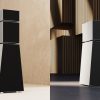All receivers should have inputs for the full range of video connectors — composite, S-video, component video, and HDMI. With the popularity and standardization of HDMI, the clunkier DVI inputs have largely disappeared. If you have an older DVD upconverting player with only a DVI output, you can get a DVI/HDMI adaptor. With increasing price, the number and variety of inputs and outputs, especially HDMI, increases. The over-$1,000 models typically feature three or more HDMI inputs, and plenty of analog and digital inputs and outputs, both optical and (less commonly) coaxial.
Entry-level AV receivers may offer only simple HDMI switching of connected components but you’ll want to make sure that whichever AV receiver you choose, the HDMI “version” is compatible with your HDTV’s input and with any upcoming purchase of HDMI-equipped components such as a Blu-ray player or gaming system. The latest HDMI version is 1.3, but earlier versions will carry many of the high-resolution audio formats.
If you anticipate getting a separate power amplifier with much greater power output in the future, then make sure the AV receiver has “pre-outs” (preamplifier output jacks) for all channels.
Multi-channel Surround Sound Decoding
In most installations, your AV receiver will do much of the work of “decoding” the various new and older surround sound formats. There are now ten surround formats, Dolby Digital 5.1 being the standard of HDTV broadcasts and standard DVDs. The ten formats are: Dolby Digital (5.1), Dolby Digital EX, Dolby Digital Plus, Dolby TrueHD, DTS, DTS-ES, DTS-HD, DTS-HD Master Audio, Dolby Pro Logic II, Dolby Pro Logic II x. Additionally, you will find Logic7 on Harman/Kardon and Lexicon models. Classical music fans may appreciate the extra ambience, depth and expanded soundstage that Logic7 often imparts to good classical stereo recordings. Logic7 is comparable to Dolby Pro Logic II(x) or DTS Neo:6, all of which will take a 2-channel stereo source and synthesize center and surround channels to approximate 7.1-channel playback.

The “important” surround formats on inexpensive AV receivers are Dolby Digital and Dolby Pro LogicII x, now almost universal on even entry-level models. You’ll also find various DTS codecs comparable to the Dolby Digital variations, which some enthusiasts like better for DTS’s somewhat exaggerated deep bass effects. If you want to have the latest high-resolution multi-channel audio formats — Dolby TrueHD, DTS-HD (Master Audio) and Dolby Digital Plus — common to Blu-ray high-definition discs, you’ll be looking at AV receivers in the upper price range. However, as Blu-ray and its associated hi-res soundtracks become more common, prices will fall. As of this writing (April 2008), Onkyo just announced an AV receiver (the TX-SR606) in the $500 price range that will decode Dolby TrueHD and DTS-HD (Master Audio) as well as having four HDMI 1.3a-compatible inputs. You can expect other brands to soon follow Onkyo’s lead.
A lower-priced AV receiver (or an older model) lacking these capabilities doesn’t mean you can’t hear the newest soundtrack formats from a Blu-ray player. As long as any AV receiver has a multi-channel (usually eight) analog input set, then a Blu-ray player will do the decoding of Dolby TrueHD, DTS Master Audio or Dolby Digital Plus, and route the signals to the Blu-ray player’s analog 6 or 8-channel outputs. It just means a messier connection, with either six or eight analog RCA cables between the Blu-ray player and your AV receiver’s multi-channel input set.
On-screen Display
Make sure the AV receiver has a legible on-screen display so you can navigate the receiver’s settings during setup and calibration. Most AV receivers will have on-screen options for component-video outputs, but typically only more expensive models offer an on-screen display with the HDMI outputs.
Auto-Setup and Calibration
Even inexpensive AV receivers now have some type of auto-setup mode, with many including a supplied microphone and auto-calibration/equalization circuit (Audyssey is very common) that claims to adjust the frequency response of the system’s speakers to match the room’s characteristics.
While the auto-setup modes are initially useful for first-timers, they are still prone to error, sometimes setting speakers that are small to “Large” and making errors in speaker level settings of 4 dB or more. You should still do a manual check using a sound-level meter and a pink-noise signal.
Unless you have really poor speakers, I recommend you turn off the auto-EQ circuits. They may help smooth out the non-linear spikey frequency response of poorly designed speakers, but with really smooth linear speakers like Axioms, they often degrade sound quality.
Check the Remote Control
Remote control design is all over the map, and you often find a really desirable AV receiver with an annoying remote control that has illegible markings, lacks backlighting or uses tiny buttons all the same size. One can get used to almost any remote, but remotes with larger, different-shaped buttons, backlighting, and easily readable markings go a long way to making a remote control easy to use.
Video Processing
Your new HDTV set will automatically do its own video processing, “scaling,” de-interlacing and trans-coding (convert) incoming video signals in order that they conform to your set’s specific fixed-pixel array (the latter is common to all plasma, LCD, and DLP displays). Many AV receivers also contain video processors that will perform similar functions. The question remains as to which unit — your AV receiver or DVD player or the HDTV — does a better job. It’s generally agreed that there should only be one conversion take place for maximum picture quality; adding more than one may degrade the video image and add various visible processing artifacts. In any case, be sure to set your HD cable-TV converter box (or satellite receiver) to output video at the native resolution of your HDTV display (720p or 1080i). If you have a 1080p display, try setting the cable box to either 720p or 1080i and see which produces the better picture.
For the record, the three operative terms that define upconversion are:
- Transcoding, which is converting one signal format like S-video to another, say component video.
- Deinterlacing, which converts an interlaced video signal (480i or 1080i) to progressive-scan, e.g. 480i to 480p or 1080i to 1080p.
- Scaling, which alters the video signal from one resolution to another, like going from 480p to 720p.
That’s it. For more detailed questions, send us an email or post your question to our Axiom forums, accessible on the Axiom home page, where many Axiom enthusiasts will help set you straight.






























